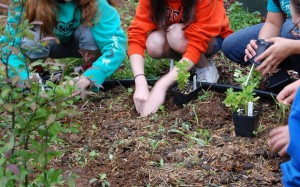14
Aug
Think Green, Practice Organic This Semester!
(Beyond Pesticides, August 14, 2013) With another school year upon us, this can be an exciting and busy time of the year for parents and teachers as children prepare for the first day back. During this hectic time, it’s important to remember that children may face unexpected dangers at school from well-intentioned but misguided attempts to create a germ and pest-free environment through the use of pesticides.
Students are better served when schools use environmentally friendly products and practice integrated pest management techniques. Additionally, schools can further their students’ education outside the classroom by providing habitat for wildlife and growing organic food in a school garden. By thinking green and going organic, your child’s school can become a model for the type of change that’s occurring in communities across the nation. Beyond Pesticides has put together this back-to-school guide to help safeguard your kids from dangerous chemicals at school. Use this list to start the new school year right and ensure that you are sending your kids back to a healthier and safer environment.
Fight Germs Without Triclosan
Because of its link to adverse health effects – including asthma, cancer and learning dis abilities, triclosan has no place in the classroom. The American Medical Association recommends against its use in consumer products, and the FDA states that, “Existing data raise valid concerns about the [health] effects of repetitive daily human exposure to [triclosan]…” The EPA which also regulates this chemical has only now begun to review its registration.
The take home here is that regular soap and water is just as effective at getting rid of bacteria.
Subtract Triclosan from the Equation: Tell your principal that you are concerned about the use of antibacterial soap and its impact on the health of the students and staff. Ask that the school order regular soap from its usual janitorial product supplier and that all cleansers and sanitizers used by the school be triclosan-free. Materials on the health impacts of triclosan are available at Beyond Pesticides.
Recently students at the University of Texas passed a resolution banning triclosan soaps. You too can encourage your school to adopt an official policy that 1) commits to not procuring or using products containing triclosan or triclocarban; 2) supports efforts to educate the community about the action it has taken. Contact us for model policy language and tips on how to get started.
It’s easy to avoid triclosan. Read the product label, whether it’s a backpack, school supplies, soap or sanitizer for any label statement that says “antibacterial,”or “antimicrobial protection.” Due to public pressure, many companies have reformulated their products without triclosan. Below are some brands that do not use triclosan:
- CleanWell
- Nature’s Gate
- Crest
- Ivory
- Dr. Bronner’s Magic Soaps
- Purell
- Tom’s of Maine
- Listerine
- Kiss My Face
Sign the pledge and go triclosan-free.
Don’t Let DEET Get You Down
Recently, there have been recommendations that DEET, the mosquito repellent, can be used safely. But do not believe this misinformation. Studies have shown the DEET can impair muscle movement and function, learning and memory. When used together with permethrin, another ingredient commonly found in mosquito products, the risk of these effects increases.
First, the best way to protect your kids from these mosquito pesticides is to wear long pants and long sleeves, especially when mosquitoes are most active (dusk). There are other viable alternatives including:
- Oil of Lemon Eucalyptus – CDC recommends lemon eucalyptus oil repellents as a good alternative to DEET. According to CDC, this plant-based mosquito repellent provides protection time similar to low concentration DEET products.
- Picaridin (KBR 3023), dervived from pepper, also provides comparable protection as DEET products with similar concentrations.
- Essential oils – Other essential oils used in repellents include Cedarwood, Soybean Oil, Garlic Oil, and Geraniol can provide protection against mosquitoes.
For more information on keeping your family safe from mosquitoes, visit Beyond Pesticides’ mosquito management web page.
Pollinators are very important to our ecosystem and agriculture. However, many pollinators, like honey bees, bumble bees, birds, and butterflies, are declining due to loss of habitat, widespread use of toxic pesticides, parasites, and disease. You and your school can play a part to help these important creatures by (1) not using toxic pesticides, (2) planting pollinator habitat, and (3) educating your friends and family. Here are some steps to BEE Protective:
– Encourage your school to plant pollinator-attractive plants in its garden as part of its biology class. If your school does not have a garden, request one be integrated into the curriculum. Wildflowers, native plant and grass species should be encouraged on school grounds. See our BEE Protective Habitat Guide for more information on attractive flowers.
– Improve your school’s integrated pest management (IPM) policy by encouraging staff not to use pesticides that are harmful to honey bees and other pollinators, and to apply least-toxic pesticides only when bees or other pollinators are not foraging on blooming flowers. See a list of neonicotinoid products to especially avoid.
– Have your school pass a resolution to ban neonicotinoid pesticides that are toxic to honey bees and other pollinators. A model resolution can be obtained here.If you school has pollinator-friendly habitat, pledge your school as pollinator-friendly and indicate how many acres (or fraction of an acre) your school can declare.
For more on how to BEE Protective, click here.
Keep Schools Green: Take Pesticides Out of Schools and Playgrounds
Children face unique hazards from pesticide exposure because of their small size and developing organ systems. Many school officials and groundskeepers think that the only way to ensure pests are kept at bay and good turf growth is with chemical pesticides and synthetic fertilizers. However, many schools around the country are realizing that a defined integrated pest management (IPM) program is one of the best ways to eliminate children’s exposure to pesticides in school buildings, and organic turf management, similarly, eliminates hazards on playing fields and playgrounds.
A good IPM is a program will have strictly defined processes of prevention, monitoring and control, as well as record keeping, which offers the opportunity to eliminate harmful pesticides in schools, where only the least toxic option is used. Improving a school’s pest management program requires perseverance, as administrators and grounds staff may be uninformed. One major selling point is that, when it comes to playing fields, organic turf management systems cost as much as 25% less than chemical-intensive systems.
To learn more about how to improve your school’s pest management policy, both indoors and outdoors, see our School Organizing guide. Learn more about the 30 of the most commonly used chemicals on athletic fields that can cause numerous health risks to children, including glyphosate (Roundup) and 2,4-D. Also see organic management of school fields in our Pesticides and Playing Fields fact sheet and the Lawns and Landscapes page.
Give Your Kids An Organic Diet Where Possible
In addition to serious health questions linked to actual residues of toxic pesticides on the food we eat, our food buying decisions support or reject hazardous agricultural practices, protection of farmworkers, and stewardship of the earth. Buying certified organic food is the only way to be sure that what you and your family eat comes from a system that rejects hazardous synthetic chemicals. There is documented evidence that children fed a pure organic diet have significantly lower levels of pesticides in their system than children fed a diet of conventionally produced food. The American Academy of Pediatricians has states that foods without pesticide residues are significant for children. If you are unable to eat all organic, purchase organic varieties of the foods you and your kids eat most often.
It’s easiest to go organic when you grow organic. School gardens and other farm-to-school programs teach children where food comes from and establish healthy relationships with food and the natural world. An organic garden starts with healthy soil using natural sources of fertility such as compost, and schools have a great built-in source of potential compost feedstock in kitchen scraps and cafeteria leftovers.
You can increase the amount of organic food your child eats while decreasing his or her exposure to toxic pesticides and lessening your impact on the environment by asking your school to adopt an organic lunch program or helping to start an organic school garden. For more information, see Eating with a Conscience, “School Lunches Go Organic,” and “The Organic School Garden.”
All unattributed positions and opinions in this piece are those of Beyond Pesticides.











